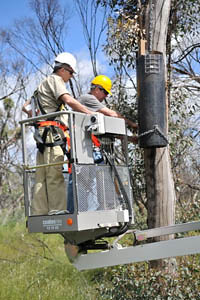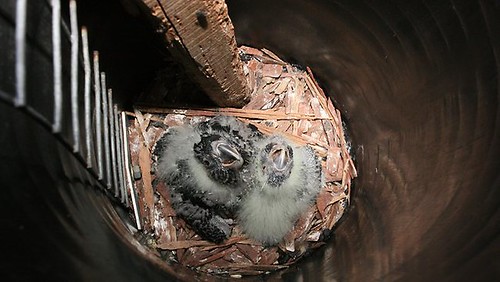Carnaby's handed Wheatbelt lifeline
 Monday, October 3, 2011 at 23:54
Monday, October 3, 2011 at 23:54 More than 30 artificial nesting hollows have been installed and 25 natural ones repaired near Badgingarra, 212km north of Perth, after populations of the endangered birds dropped from 100 to 43 in the past 12 months.  Careful work: DEC senior wildlife officer Rick Dawson (left) and Des Mant from Palm Beach Rotary Club installing the hollows.DEC senior wildlife officer Rick Dawson said a fire destroyed 18 hollows in 2009 and those that survived are being used by galahs.
Careful work: DEC senior wildlife officer Rick Dawson (left) and Des Mant from Palm Beach Rotary Club installing the hollows.DEC senior wildlife officer Rick Dawson said a fire destroyed 18 hollows in 2009 and those that survived are being used by galahs.
“In 2009, a bushfire destroyed 18 Carnaby’s hollows that have been used for decades and killed three chicks in three nests, placing the local population under even more pressure,” Mr Dawson said.
“Competition for the small number of remaining hollows in the burnt area was intense, with all hollows being used by Carnaby’s cockatoos showing evidence of nesting attempts by galahs.”
“Research has shown that Carnaby’s cockatoos will readily breed in artificial hollows that are installed at breeding sites,” he said.
Carnaby's Black-Cockatoo populations have declined by more than 50 per cent in the past 45 years with a third of former Wheatbelt breeding sites no longer in use. The team: DEC senior wildlife officer Rick Dawson (left) with the Palm Beach Rotary Club at Coomallo Creek. Photos Rick Dawson DEC.The species has been pushed to the brink of extinction by land clearing and competition from other animals.
The team: DEC senior wildlife officer Rick Dawson (left) with the Palm Beach Rotary Club at Coomallo Creek. Photos Rick Dawson DEC.The species has been pushed to the brink of extinction by land clearing and competition from other animals.
A study of artificial nesting sites in March revealed the birds will use artificial nests if they are correctly erected in breeding areas.


